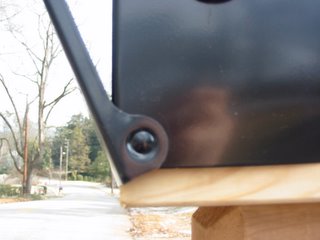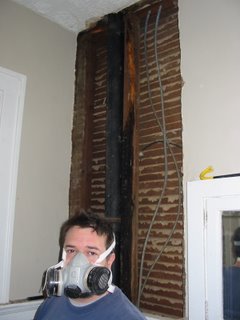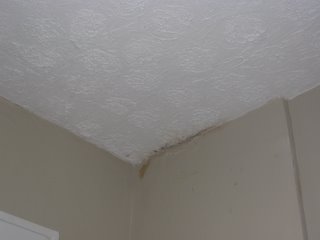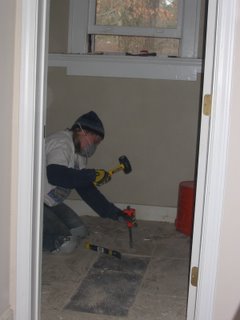It was Chuck's idea to start stripping the woodwork in the bathroom. Delusions of grandeur filled his head about returning the wood to its original glory, and he convinced me to partake. We are FINALLY finished, and I could write for days about how much work the stripping was. How it took waaaay longer than we ever thought it would and put us almost 2 weeks behind our schedule, the probability of lead paint, the chemical stripper fumes, the cold weather, the sore arms, the MESS. blah blah blah boring. Instead, i'm going to share the tools and methods we found the most useful, and show you some before and afters.
The first project that gave Chuck wood was the medicine cabinet.

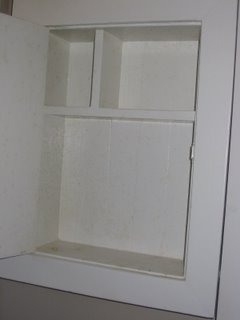
When anticipating our stripping project, we asked the man at Home D for the least toxic stripping product, hoping to save our innards. He recommended Citristrip. In retrospect, we probably would have been better off getting the most toxic, and therefore effective, stripping product, and saved ourselves the inhalation of the heat-induced lead paint fumes. Lesson learned.
We plopped some orange citrus goop on the medicine cabinet before leaving for the night, and came back to this cool Freddy Krueger spectacle next day:

All seemed hopeful as I donned my latex gloves and went to work on the top layer of paint which melted away at the dull edge of my cheap plastic stripper tool, also recommended by the aforementioned Home D guy, as it was supposed to be easier on wood:
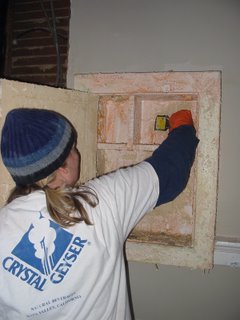
Revealed were several other, thicker layers of paint. Calling up a recent episode of Flip That House, we took to the heat gun and switched to a stripping tool with a metal edge. Some elbow grease, a final thin layer of orange goop and a quick pass with the hand sander revealed this:
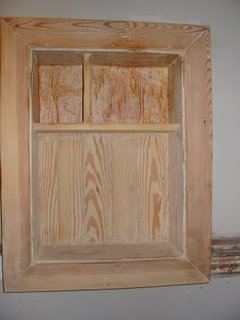
Victory. We took the front part with the mirror off to tackle separately. I'm still trying to get the (orange + black = gray) goop out of the little grooves, so it remains a work in progress. However, the interior of the cabinet was a relatively quick strip and convinced us that the rest would be a breeze.
Armed with our success, we hit the molding. This is where it got a little tricky. This time, we started with the heat gun, because the goop/paint mixture on the top layer makes such a mess and accomplishes very little. The heat gun is very effective, though rather time consuming and very labor intensive. You have to heat the paint just enough to get it to bubble, but be sure that you don't leave it on so long that you burn it. And you have to stop every 30 seconds or so to wipe the hot paint off of your tool, which to me was the most irritating part. The top layer of recent white paint came off pretty easily. However, it revealed a layer of maize-colored oil paint that was the consistency of glue, and has consequently given me tennis elbow.

And the multiple grooves of our lovely molding were nearly impossible to get the paint out of. In utter frustration, I finally took to them 'no more wire hangers'-style with a brass bristled brush and mineral spirits, but unfortunately wasn't able to get all of the paint off without taking a few small bits of the wood with it. OK, it was more like a lot of small chunks of wood, which Chuck kindly pointed out to me.
All in all, taking the paint off of a 2" wide x 2" deep chair rail molding in a 6' x 7' room took the better part of 2 weeks. Throughout that time period, we bought and sampled every stripper tool on the market. And toward the end, developed a pretty effective method for accomplishing this grueling task. Note: immediately pitch any plastic edged stripping tool that you own. Completely useless.
You should be able to accomplish all stripping tasks with a combo of a heat gun and Citristrip, and these 3 tools:
A double edge wood scraper. Good for larger surfaces, really lets you dig in to layers of without hurting the wood.

A single edge wood scraper. Good for small surfaces that you can't get into with the larger tools.
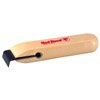
And my favorite, the 10 in 1 tool. I only know what 3 of the 10 things are that it does (1 of them being a bottle opener) but it proved to be the most versatile, and therefore effective, of all of the stripping tools.

As we near the end, I have to ask myself, was it worth the work? I can't say that if we had the decision to make again knowing what we know now (which is that it is a lot of work - did I mention that?) that we would have gone through with it. Especially, since we ultimately decided that in keeping with the style of our renovated bathroom, we will likely be painting the wood we stripped. That being said, now this beautiful original woodwork will have 1 layer of paint on it and not 10, and I do believe this will make a difference. As soon as we finish sanding, I will post some pictures, and you can decide for yourselves.
To close, here is a helpful home remedy tip from our handyman, Lee Tucker:
In order to keep your kitchen drain from EVER clogging up, pour a gallon of clorox & a gallon of vinegar down the drain, and rinse with a lot of hot water. Do this every month for four months in a row, then every 6 months as maintenance. He swears by this preventive measure, as he has lived in his home for 33 years, and has NEVER had a drain clog. We had a clog and we used drano. We were reprimanded. Drano is bad. Good to know.












